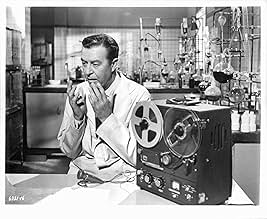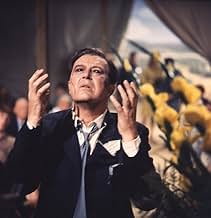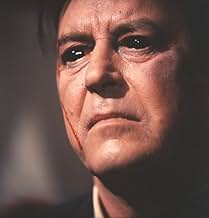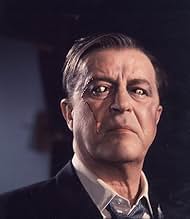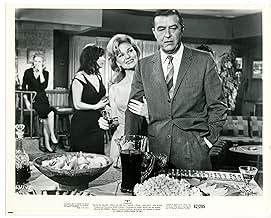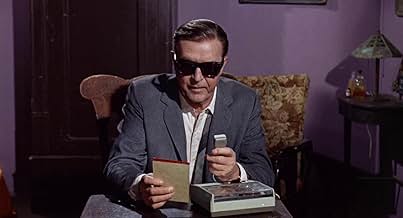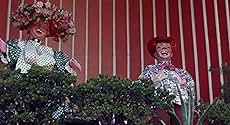CALIFICACIÓN DE IMDb
6.6/10
8.8 k
TU CALIFICACIÓN
Un médico usa gotas especiales para los ojos para obtener visión de rayos X, pero el nuevo poder tiene consecuencias desastrosas.Un médico usa gotas especiales para los ojos para obtener visión de rayos X, pero el nuevo poder tiene consecuencias desastrosas.Un médico usa gotas especiales para los ojos para obtener visión de rayos X, pero el nuevo poder tiene consecuencias desastrosas.
- Dirección
- Guionistas
- Elenco
- Premios
- 2 nominaciones en total
Diana Van der Vlis
- Dr. Diane Fairfax
- (as Diana van der Vlis)
Budd Albright
- Dance sequence
- (sin créditos)
Leon Alton
- Casino Patron
- (sin créditos)
Morris Ankrum
- Mr. Bowhead
- (sin créditos)
Benjie Bancroft
- Dealer
- (sin créditos)
George DeNormand
- Medical Board Member
- (sin créditos)
John Dierkes
- Preacher
- (sin créditos)
Bobby Gilbert
- Man Outside Office
- (sin créditos)
Stuart Hall
- Casino Patron
- (sin créditos)
Kathryn Hart
- Mrs. Mart
- (sin créditos)
Ed Haskett
- Casino Patron
- (sin créditos)
Jonathan Haze
- Heckler
- (sin créditos)
Harvey Jacobson
- Casino Boss
- (sin créditos)
Vicki Lee
- Young Girl Patient
- (sin créditos)
Opiniones destacadas
To this writer, the film is Roger Corman's best entry into sci-fi. Many of his 50s efforts hold a certain campy charm, with their low-budget effects - and this film is similar in that regard. It does not dwell on the effects, in fact some of them are rather poor. What it does have in its favor is a tight screenplay that gets into the story quickly, as will the viewer - and it's engrossing enough and the characters interesting enough that one stays involved through the episodic story.
What it has most in its favor is an excellent performance from Ray Milland, then in his last days being top-billed, and he milks it for all that it's worth. In some scenes Corman goes for a direct close-up and Milland's facial reactions indicate that he took the the role in a small-budget/tight schedule film with all the enthusiasm that he did in one of his roles for Alfred Hitchcock ("Dial M For Murder") or Fritz Lang ("Ministry of Fear"). Smooth, refined, but a man of immediate action if necessary, Milland's Dr. Xavier is not your usual mad scientist. As with Claude Rains in "The Invisible Man" or Al Hedison in "The Fly" he's the scientist who made the mistake of being his own subject.
Occasionally Corman goes for the cheap gag (the party sequence, where Xavier examines the guests sans attire - but inoffensive in a typical 60s approach), but the carnival scenes and the basement healer scenes show a maturity to Corman's direction, and these scenes are greatly helped by the performance of Don Rickles. He's as sleazy as one can get and admits that if he had the power, he would use it to see "all the undressed women my poor eyes can stand" and you believe it. A scene where Milland confronts other carnival workers who are speculating on his "power" shows the doctor to be both introspective and world weary at the same time. At this point even he does not know what to do with his ability, but Rickles' suggestion of setting up a site to "heal" others leads to the film's most revealing and almost poetic sequence. Xavier's original intention was to help the ill, but his implication in an accidental murder led him to seek refuge in the carnival Richard Kimble-style.
Diana Van Der Vlis does well with her underwritten role in which at one point she's rather quickly dropped, and then resurfaces rather conveniently later in the story - to no great effect. This was only her second feature film, though she had done a number of TV guest shots. Although half Milland's age, she seems more mature than her 28 years and they make a believable pair. A bonus is the appearance of a number of veterans in brief roles - John Hoyt, Harold J. Stone, John Dierkes and Morris Ankrum, as well as Corman stalwart Dick Miller. Miller shares his scenes with Jonathan Haze, whom it appears was getting the cheapest rate Corman could pay as he has no lines at all. He was rather bitter about this as he revealed in an interview years later.
Floyd Crosby's cinematography belies the small budget - only $300,000 and a shooting schedule of about three weeks. According to Corman they did rehearse a bit more than usual - and in the finished product it shows. He claims he even went as high as four takes, which may not exactly put him in William Wyler or Stanley Kubrick territory, but it's a far cry from what he'd do in the 50s. Les Baxter contributes what may be my favorite of his scores, fully complimentary to the action on screen without overwhelming it.
There's a bit of controversy over the ending - some attribute an extra line of dialog that never appeared in any print that I've seen, but it is still one of the most surprising endings of any sci-fi film since "The Incredible Shrinking Man." That it won the top prize at the Trieste Science Fiction Film Festival would be enough for one to be curious enough to see it even this many years later - that it has held up so well over 40 years points to that award's validity.
What it has most in its favor is an excellent performance from Ray Milland, then in his last days being top-billed, and he milks it for all that it's worth. In some scenes Corman goes for a direct close-up and Milland's facial reactions indicate that he took the the role in a small-budget/tight schedule film with all the enthusiasm that he did in one of his roles for Alfred Hitchcock ("Dial M For Murder") or Fritz Lang ("Ministry of Fear"). Smooth, refined, but a man of immediate action if necessary, Milland's Dr. Xavier is not your usual mad scientist. As with Claude Rains in "The Invisible Man" or Al Hedison in "The Fly" he's the scientist who made the mistake of being his own subject.
Occasionally Corman goes for the cheap gag (the party sequence, where Xavier examines the guests sans attire - but inoffensive in a typical 60s approach), but the carnival scenes and the basement healer scenes show a maturity to Corman's direction, and these scenes are greatly helped by the performance of Don Rickles. He's as sleazy as one can get and admits that if he had the power, he would use it to see "all the undressed women my poor eyes can stand" and you believe it. A scene where Milland confronts other carnival workers who are speculating on his "power" shows the doctor to be both introspective and world weary at the same time. At this point even he does not know what to do with his ability, but Rickles' suggestion of setting up a site to "heal" others leads to the film's most revealing and almost poetic sequence. Xavier's original intention was to help the ill, but his implication in an accidental murder led him to seek refuge in the carnival Richard Kimble-style.
Diana Van Der Vlis does well with her underwritten role in which at one point she's rather quickly dropped, and then resurfaces rather conveniently later in the story - to no great effect. This was only her second feature film, though she had done a number of TV guest shots. Although half Milland's age, she seems more mature than her 28 years and they make a believable pair. A bonus is the appearance of a number of veterans in brief roles - John Hoyt, Harold J. Stone, John Dierkes and Morris Ankrum, as well as Corman stalwart Dick Miller. Miller shares his scenes with Jonathan Haze, whom it appears was getting the cheapest rate Corman could pay as he has no lines at all. He was rather bitter about this as he revealed in an interview years later.
Floyd Crosby's cinematography belies the small budget - only $300,000 and a shooting schedule of about three weeks. According to Corman they did rehearse a bit more than usual - and in the finished product it shows. He claims he even went as high as four takes, which may not exactly put him in William Wyler or Stanley Kubrick territory, but it's a far cry from what he'd do in the 50s. Les Baxter contributes what may be my favorite of his scores, fully complimentary to the action on screen without overwhelming it.
There's a bit of controversy over the ending - some attribute an extra line of dialog that never appeared in any print that I've seen, but it is still one of the most surprising endings of any sci-fi film since "The Incredible Shrinking Man." That it won the top prize at the Trieste Science Fiction Film Festival would be enough for one to be curious enough to see it even this many years later - that it has held up so well over 40 years points to that award's validity.
Dr Xavier (Ray Milland) thirst of knowledge experiments with a formula on his owns eyes which will allow to see through solid material. As he can read a closed book , making diagnosis ills , and seeing naked people. He can literally observe through things , watching beyond of visible lights and turning into a rarefied figure as mad doctor. Then the staff intends to cut off his funds for further research . But an accident takes place , dieing a medic (Harlod J Stone), as he flees and the newspapers publicize , as the Angeles Daily Sun : ¨Doctor falls to death¨, ¨Physician murdered¨ and the Angeles Chronicle : ¨Doctor killer flees¨. Later on , Xavier wearing dark glasses works at a sideshow (ruled by Don Rickles) as fortune teller and finally as psychic consultant. Such increased powers of perception and knowledge bring him neither happiness nor strengthening but transform him an outcast, unsettling person.
A stylish and first-rate film , confidently realized and plenty of eye-popping moments referred to the visions. The basic opposition between blindness and vision is a central key of this interesting work. Good performances from Ray Milland as doctor who gains power to see beyond, Harold J Stone as unfortunate medic who accidentally falls and Don Rickles as ambitious manager . Appears uncredited notorious secondary cast as Morris Ankrum, John Hoyt, and John Dierkes as preacher. Furthermore unbilled actors of the Corman factory as Dick Miller and Jonathan Haze. It packs not withstanding and weak special effects made by date means. Rare musical score by Lex Baxter and colorful cinematography by Floyd Crosby, booth of whom are habitual of Roger Corman.
After his period realizing poverty-budget horror movies as ¨Swamp woman, The beast with a million of eyes, Attack of the crab monsters , Undead¨, then came the cycle of tales of terror based on Poe as ¨ House of Usher, Pit and pendulum, The raven , Tales of terror, The masque of the red death ¨ , and Corman made this undisputed masterpiece , X , that won the Golden Asteroid in the Trieste Festival of Science Fiction Films in 1963. Rating : Above average, definitively wholesome watching , Corman's achievement to have bent the Sci-Fi genre with splendid results.
A stylish and first-rate film , confidently realized and plenty of eye-popping moments referred to the visions. The basic opposition between blindness and vision is a central key of this interesting work. Good performances from Ray Milland as doctor who gains power to see beyond, Harold J Stone as unfortunate medic who accidentally falls and Don Rickles as ambitious manager . Appears uncredited notorious secondary cast as Morris Ankrum, John Hoyt, and John Dierkes as preacher. Furthermore unbilled actors of the Corman factory as Dick Miller and Jonathan Haze. It packs not withstanding and weak special effects made by date means. Rare musical score by Lex Baxter and colorful cinematography by Floyd Crosby, booth of whom are habitual of Roger Corman.
After his period realizing poverty-budget horror movies as ¨Swamp woman, The beast with a million of eyes, Attack of the crab monsters , Undead¨, then came the cycle of tales of terror based on Poe as ¨ House of Usher, Pit and pendulum, The raven , Tales of terror, The masque of the red death ¨ , and Corman made this undisputed masterpiece , X , that won the Golden Asteroid in the Trieste Festival of Science Fiction Films in 1963. Rating : Above average, definitively wholesome watching , Corman's achievement to have bent the Sci-Fi genre with splendid results.
Here is Corman at almost his best. Ray Milland was as good an actor as Vincent Price, and this story isn't trapped in the Poe mode of rotting flesh and dilapidated mansions. It's more in the manner of Corman's The Trip, which was made a few years later. Dr. Xavier discovers something that he can use to see through solid objects, but its effect is cumulative, and by the end of the movie he's seeing all the way to the core of reality.
Of course, he has to go on the run, and must abandon his medical career. We see him in a carnival, reading peoples' thoughts, and later teaming up with his x girlfriend and going to Vegas and seeing through the cards and winning big, and finally, escaping from the police, and as he drives through the Nevada desert, we see that he can't see a thing. Abandoning his Lincoln Continental, he stumbles into a tent revival meeting. The preacher, played by Royal Dano(?)is telling his followers to throw Satan out. Filmed by Floyd Crosby, with beautiful special effects, this is a real piece of 60's film-making by one of the masters.
Of course, he has to go on the run, and must abandon his medical career. We see him in a carnival, reading peoples' thoughts, and later teaming up with his x girlfriend and going to Vegas and seeing through the cards and winning big, and finally, escaping from the police, and as he drives through the Nevada desert, we see that he can't see a thing. Abandoning his Lincoln Continental, he stumbles into a tent revival meeting. The preacher, played by Royal Dano(?)is telling his followers to throw Satan out. Filmed by Floyd Crosby, with beautiful special effects, this is a real piece of 60's film-making by one of the masters.
This is one of my favorite Roger Corman flicks. Brisk pace and many surprises. Don Rickles as a ruthless carny exploiteer is one of them. Milland wears more and more ridiculous sunglasses as the movie progresses.
Seriously, this is one of Don Rickles' best performances -- it shows that he could have gone in a totally different direction than he followed for most of his career (as an "insult comedian") if he had wanted to. I imagine that his appearance in the film had something to do with his contract with AIP, but I still think it's a bit of VERY inspired casting (regardless of the financial reasons that may have been behind it).
Milland is also excellent in the type of role that suits him to a T... he gets to be kind of a Dr. Frankenstein here, convinced he's doing good for humanity but making himself into a monster in the process.
A memorable story with a meaning.
Seriously, this is one of Don Rickles' best performances -- it shows that he could have gone in a totally different direction than he followed for most of his career (as an "insult comedian") if he had wanted to. I imagine that his appearance in the film had something to do with his contract with AIP, but I still think it's a bit of VERY inspired casting (regardless of the financial reasons that may have been behind it).
Milland is also excellent in the type of role that suits him to a T... he gets to be kind of a Dr. Frankenstein here, convinced he's doing good for humanity but making himself into a monster in the process.
A memorable story with a meaning.
A very thoughtful, engrossing, flawed film from superhuman director/producer Roger Corman. Yep, it has some problems, most primarily dealing with a limited budget. But what it lacks in dollars it has in heart and its ability to make you think about what we are missing out seeing with our vision. I am not sure that much, or even any, scientific creedence can be given to the idea behind the experiments of Dr. Xavier James and his search to see beyond what normal vision allows. Ray Milland gives a fine performance as the obsessed man out to continue his experiments even if they involve using himself as the human guinea pig. Some of the scenes and dialogue are a bit hokey by today's standards but most fit the film very nicely. The scene with Milland at a party is a real hoot and great comedic relief. I also loved the end to the film but thought it could have been plucked out a little longer. The effects are very sparse and the only ones I really thought were any good were the ones used to highlight Milland's eyes through the film. The film boasts a fine cast of stalwart sci-fi/Corman people such as Morris Ankrum, Dick Miller, Jonathan Haze, and Barboura Morris, as well as a young(and obviously talented) Don Rickles. Definitely try to see your way to seeing this film.
¿Sabías que…?
- TriviaTo create the effect of being able to see through a building, the director filmed the building while it was under construction.
- ErroresThe first X-ray that Dr. Xavier quizzes Dr. Fairfax with is a normal chest X-ray. There is no bullet on that film. Bullets show up very well on X-rays.
- Citas
Dr. Diane Fairfax: What do you see?
Dr. James Xavier: The city... as if it were unborn. Rising into the sky with fingers of metal, limbs without flesh, girders without stone. Signs hanging without support. Wires dipping and swaying without poles. A city unborn. Flesh dissolved in an acid of light. A city of the dead.
- Versiones alternativasThrough an apparent lab error, some of the 16mm U.S. television syndication prints had the ending credits in Spanish.
- ConexionesEdited into Gli ultimi giorni dell'umanità (2022)
Selecciones populares
Inicia sesión para calificar y agrega a la lista de videos para obtener recomendaciones personalizadas
- How long is X: The Man with the X-Ray Eyes?Con tecnología de Alexa
Detalles
- Fecha de lanzamiento
- País de origen
- Idioma
- También se conoce como
- El hombre con visión de rayos X
- Locaciones de filmación
- Queen of Angels Hospital - 2301 Bellevue Avenue, Los Ángeles, California, Estados Unidos(Establishing shot of hospital.)
- Productora
- Ver más créditos de la compañía en IMDbPro
Taquilla
- Presupuesto
- USD 250,000 (estimado)
- Tiempo de ejecución
- 1h 19min(79 min)
- Mezcla de sonido
- Relación de aspecto
- 1.85 : 1
Contribuir a esta página
Sugiere una edición o agrega el contenido que falta


